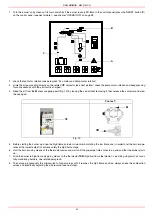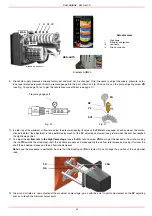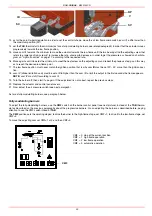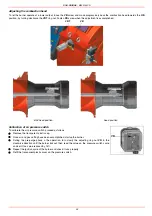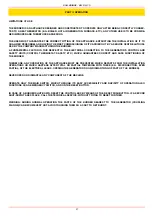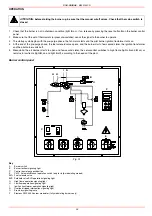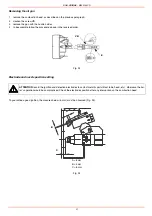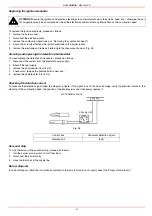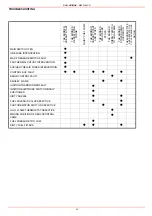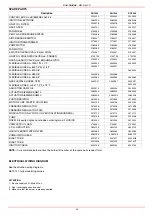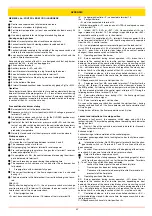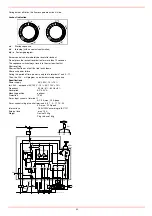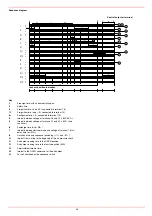
42
SIEMENS LAL.. CONTROL BOX FOR OIL BURNERS
Use
Control and supervision of oil atomization burners
For burners of medium to high capacity
For intermittent operation (at least one controlled shutdown every 24
hours)
Universally applicable for multistage or modulating burners
Housing and plug-in base
Made of impact-proof and heat-resistance black plastic
Lockout reset button with viewing window; located behind it:
Lockout warning lamp
Lockout indicator coupled to the spindle of the sequence switch and
visible in the transparent lockout reset button
uses easy-to-remember symbols to indicate the type of fault and the
point in time lockout occurred
Base and plug-in section of the LAL... are designed such that only burner
controls of the LAL... family can be plugged in.
24 connection terminals
Auxiliary terminals «31» and «32»
3 earth terminals terminating in a lug for earthing the burner
3 neutral conductor terminals prewired to terminal 2
14 knockout holes for cable entry by means of cable glands
8 at the side
6 in the bottom of the base
6 lateral threaded knockout holes for cable entry glands Pg11 or M20
Operation
Flame detector and flame simulation test are made automatically during
burner off times and the prepurge time «t1». If loss of flame occurs during
operation, the burner control will initiate lockout. If automatic repetition of
the startup sequence is required, the clearly marked wire link on the plug-
in section of the LAL... must be cut away.
Pre-conditions for burner startup
Burner control is not in the lockout position
Sequence switch is in its start position (with LAL2 voltage is present at
terminals 11 and 12.
Air damper is closed; end switch «z» for the CLOSED position must
feed power from terminal 11 to terminal8.
Contact of the limit thermostat or pressure switch «W» and the con-
tacts of any other switching devices in the control loop between termi-
nals 4 and 5 must be closed e.g. a control contact for the oil
preheater’s temperature
Normally closed contact of the air pressure switch must be closed.
Startup sequence
Start command by «R»:
«R» closes the start control loop between terminals 4 and 5
The sequence switch starts to run
Only prepurging, fan motor at terminal 6 receives power
Pre- and postpurging, fan motor or flue gas fan at terminal 7 receives
power on completion of «t7»
On completion of «t16», the control command for opening the air dam-
per is delivered via terminal 9
Terminal 8 receives no power during the positioning time
The sequence switch continues to run only after the air damper has
fully closed.
t1
Prepurge time with air damper fully open:
The correct functioning of the flame supervision circuit is checked
during «t1»
The burner control will initiate lockout if correct functioning is not ensu-
red.
With LAL2:
Shortly after the beginning of «t1», the air pressure switch must change
over from terminal 13 to terminal 14 otherwise, the burner control will ini-
tiate lockout start of the air pressure check.
t3
Short preignition time:
«Z» must be connected to terminal 16, release of fuel via terminal 18.
t3’
Long preignition time: «Z» connected to terminal 15.
t3n
Postignition time:
- «Z» must be connected to terminal 15
- With short preignition, «Z» remains on until «TSA» has elapsed connec-
tion to terminal 16.
t4
Interval «BV1 – BV2» or «BV1 - LR»: On completion of «t4», vol-
tage is present at terminal 19. The voltage is required to power «BV2»
connected to auxiliary switch «v» in the actuator.
t5
Interval: On completion of «t5», terminal 20 receives power. At the
same time, control outputs 9 to 11 and input 8 are galvanically separated
from the LAL...’s control section.
LAL... is now protected against reverse voltages from the load control
circuit. With the release of «LR» at terminal 20, the startup sequence of
the LAL... ends. After a few idle steps (steps with no contact position
changes), the sequence switch switches itself off.
B
Operating position of the burner
B-C
Burner operation: during burner operation, «LR» drives the air
damper to the nominal load or low-fire position, depending on heat
demand; the release of the nominal load takes place via auxiliary switch
«v» in the actuator and in the event of loss of flame during operation, the
LAL... will initiate lockout. For automatic start repetition, the clearly mar-
ked wire link «B» on the plugin section of the LAL... must be cut away.
C
Controlled shutdown: in the case of controlled shutdown, «BV...»
will immediately be closed. At the same time, the sequence switch is star-
ted to program «t6»
C-D Sequence switch travels to start position «A»
t6
Postpurge time: fan «M2» connected to terminal 7. Shortly after the
start of «t6», terminal 10 receives power and the air damper is driven to
the MIN position. Full closing of the air damper starts only shortly before
«t6» has elapsed initiated by the control signal at terminal 11. During the
following burner off time, terminal 11 is live.
t13
Permissible afterburn time: during «t13», the flame signal input
may still receive a flame signal.
D-A
End of control program: start position
As soon as the sequence switch has reached the start position – having
thereby switched itself off – the flame detector and flame simulation test
will start again.
During burner off times, the flame supervision circuit is live.
Lockout and indication of the stop position
Whenever a fault occurs, the sequence switch stops and with it the
lockout indicator. The symbol appearing above the reading mark indicates
the type of fault:
No start. One of the contacts is not closed (also refer to «Precondi-
tions for burner startup»):
Extraneous light:
Lockout during or after completion of the control program
Examples: nonextinguished flame, leaking fuel valves faulty flame super-
vision circuit.
Interruption of startup. No OPEN signal at terminal 8 from the chan-
geover end switch «a». Terminals 6, 7 and 15 are live until fault has
been corrected
P
Lockout
.
No air pressure indication at the beginning of the air pres-
sure check. Air pressure failure after the air pressure check.
Defect in the flame supervision circuit.
Interruption of the startup sequence. No positioning signal at termi-
nal 8 from the auxiliary switch «m» for the low-fire position. Terminals
6, 7 and 15 are live until fault has been corrected.
1
Lockout. No flame signal at the end of the safety time.
|
Flame signa has been lost during operation.
A
Consenso all’avviamento (ad esempio tramite il termostato o il
pressostato R dell’impianto
B
Operating position of the burner
B-C
Burner operation: during burner operation, «LR» drives the air
damper to the nominal load or low-fire position, depending on heat
demand; the release of the nominal load takes place via auxiliary switch
«v» in the actuator and in the event of loss of flame during operation, the
LAL... will initiate lockout. For automatic start repetition, the clearly mar-
ked wire link «B» on the plugin section of the LAL... must be cut away.
C
Controlled shutdown: in the case of controlled shutdown, «BV...»
will immediately be closed. At the same time, the sequence switch is star-
ted to program «t6»
C-D Sequence switch travels to start position «A».
APPENDIX
Summary of Contents for RG1025
Page 2: ......
Page 18: ...C I B UNIGAS M039144CD 18 BERGONZO NOZZLES Fig 15 ...
Page 19: ...C I B UNIGAS M039144CD 19 Fig 16 ...
Page 20: ...C I B UNIGAS M039144CD 20 Fig 17 ...
Page 21: ...C I B UNIGAS M039144CD 21 Fig 18 ...
Page 38: ......
Page 39: ......



